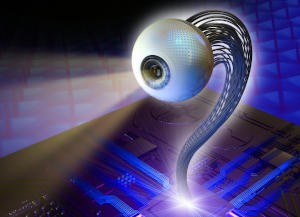Industry News
Researchers Reveal a Proof-of-Concept Bionic Human Eye
 Scientists from the Hong Kong University of Science and Technology (HKUST) have built a prototype of a new artificial eye that brings cyborgs one step closer to reality. This device, which mimics the human eye’s structure, is about as sensitive to light and has a faster reaction time than a real eyeball.
Scientists from the Hong Kong University of Science and Technology (HKUST) have built a prototype of a new artificial eye that brings cyborgs one step closer to reality. This device, which mimics the human eye’s structure, is about as sensitive to light and has a faster reaction time than a real eyeball.
“Watching sci-fi series such as Star Trek and I, Robot, I thought about making a ‘super human eye’ to be used both in humanoid robots and for the visually challenged. At that, my students thought it was yet another crazy idea of the professor,” research team leader Fan Zhiyong, a professor of Electronic and Computer Engineering at the HKUST, remarked.“Whereas the spherical human eyeball is useful for our most important visual sense and for providing a wide field of view, it can hardly be imitated because of its curved surface. Artificial eyes, currently used in hospitals and enabled by flat-surfaced integrated circuit chips, can only imitate part of the human retina to provide blurred vision. In 2012, I came up with the idea to use nanowires and external electronic circuitry to enable high-density sensors on curved surface. The resulting biomimetic eye prototype, with distance among sensing rods minimized to three micrometers, has 30 times more sensors on the artificial retina than the real human eye. This super human eye technology, with high imaging resolution, will be ready for integration into medical robots to take care of patients. It will even cater to the visually impaired when we find suitable bio-compatible materials.”
Each square centimeter of the artificial retina can hold about 460 million nanosize sensors, dwarfing the estimated 10 million cells in the human retina. This suggests that it could surpass the visual fidelity of the human eye. According to Fan, the researchers have not demonstrated the full potential in terms of resolution at this moment and a user of their artificial eye will be able to see smaller objects and further distance.
The research is published in the science journal Nature.



